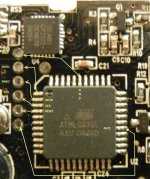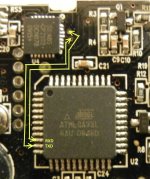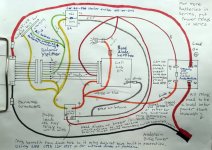heathyoung said:
Sure, I have a version on the PC here I think.
For 7 cells, you just wouldn't connect to the cell 8 tap.
The input voltage range of the cell-log is 1.3-4.9V (and so is the alarm range). Obviously, you cant hook up a 12V battery to a channel, you would fry it!
So what to do... Divide it by 4. Use a resistive divider, with an opamp buffer (ie. gain of 1) powered off the 36V tap of the battery with a series zener diode of 6.1v (the opamp is rated for 44V max) . The reason for such a high voltage rail for the opamp is that the 8th output at 15V per cell (worst case) divided by 4 (3.75) and multiplied by 8 is 30V, and the opamp is not rail-to-rail, and so needs some headroom.
You get a voltage range of 2.5 (10.0V, dead empty for a 12V AGM) to 3.75V (15.0, highest cyclic charge voltage). You can use the alarm output to turn off your charger while the zener shunts (if you do this with your AGM's) do their thing, or warn you when you hit the LVC (or you have a single battery drop like a stone, or a massive imbalance occur - delta V).
The resistor values are calculated so that you have battery voltage/4. I have a PCB design around here somewhere as well.
At the highest voltage level (120V) the resistors will only be losing 0.9mA - and dissipating 0.1W.
Yes, you will unbalance the batteries eventually, but if you pulled from the whole pack voltage with an amplified zener reg, this would not be an issue. The dividers drop less than the self discharge rate anyway, so they are negligible.
Thanks for posting this heathyoung!
I am thinking of building one of these for my 96V lead acid pack (8x 12V flooded), and am looking at a few changes... Any comments / feedback welcome

1) Balance current draw on each battery by scaling resistor dividers. I'm looking at using these Bournes 4608X series resistor arrays as each has 4 isolated resistors of the same value, perfect for creating the 1/4 divider. They don't scale perfectly of course, so I'm simulating using the following for each tap: 1-4x10k, 2-4x20k, 3-4x33k, 4-4x39k, 5-4x47k, 6-4x56k, 7-4x68k, 8-4x82k. With that I get a current from each battery of between 0.33-0.39mA at the high end of 14.5V per battery. Max power in a resistor is ~10mW, well below the rating of 300mW per element. Ratios are still 1/4 everywhere as all 4 resistors in each divider are still same value (+/- 2%).
http://www.bourns.com/data/global/pdfs/4600x.pdf
2) Blow off zeners

As long as batteries are never hooked up in wrong sequence, it seems like these should be unnecessary. The op-amp inputs are tolerant of much higher voltage than the individual battery voltage. Any noise/spikes at the Celllog shouldn't really be any worse than when used on a Li pack?
3) Run op-amps off the full pack rather than 36V tap. Since it seems like the celllog will be powered off the op-amp outputs, I'd like to spread that over the whole pack. Was thinking of using an LTC3639 to regulate the 80-116 pack voltage down to 36V.
http://www.linear.com/product/LTC3639
4) Disconnect? Would be nice to add a switch to power down the monitor. I believe people usually cut the "gnd" line between the battery and celllog to reduce drain. Still trying to wrap my head around what would happen if you also cut the gnd connection to this circuit from the battery.
Any thoughts appreciated, will post schem and share results if I get something working

Rob





